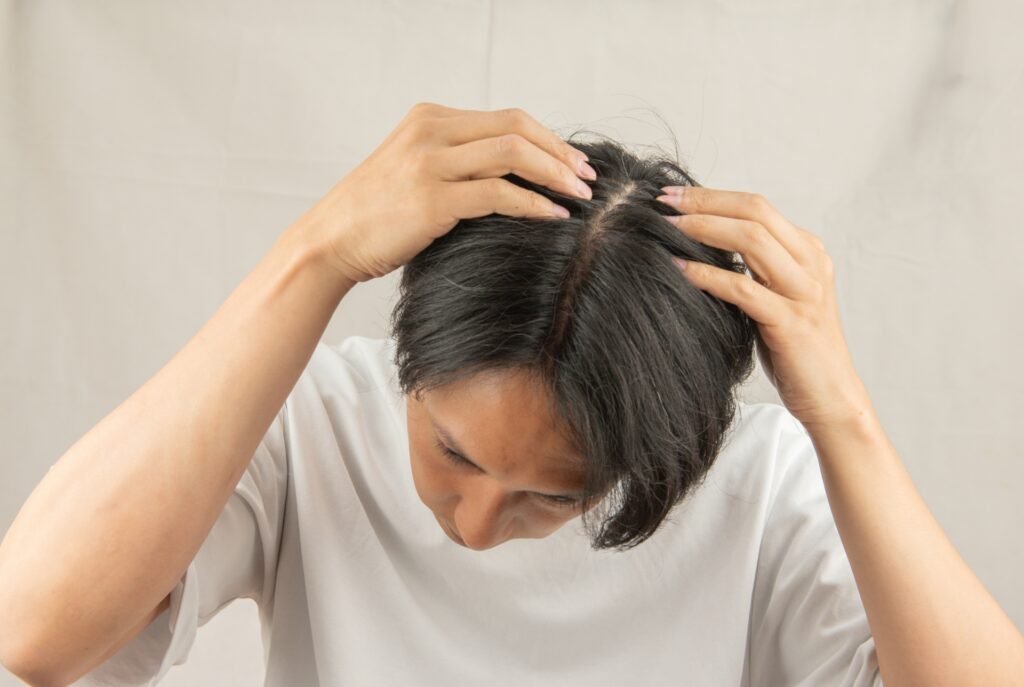If you've recently thought, "The back of my head seems to be thinning...," you're not alone-many people start to suspect AGA (Androgenetic Alopecia).
However, not all cases of thinning hair or reduced hair density at the back of the head are due to AGA.
In this article, we'll explore causes of balding at the back of the head that aren't related to AGA. provide practical methods for addressing this issue, so you can take the proper steps without worrying alone.
Contents
Balding at the Back of the Head Isn't Always AGA

Let's start by explaining why balding at the back of the head doesn't necessarily mean you have AGA.
Characteristics of AGA
AGA typically affects the hairline and crown-areas that are more sensitive to male hormones. Hair in these areas may become thinner or fall out. Hair in these areas may become thinner or fall out.
As a result, it's rare for AGA to cause balding exclusively at the back of the head. If hair loss is localized to that area, it's likely caused by another condition.
Characteristics of Balding at the Back of the Head
When hair loss is concentrated at the back of the head, you may notice more visible scalp or reduced density around the crown (whorl). As the amount of hair in that region decreases, the swirl pattern may become unclear, and the overall volume of the hair may look reduced.
Main Causes of Balding at the Back of the Head

Hair loss at the back of the head can be caused by several factors, including:: a) the hair's hair loss rate, b) the hair's hair thickness, and c) the hair's hair thickness.
-
Alopecia areata or seborrheic dermatitis-related hair loss
-
Poor scalp blood circulation or hormonal imbalance
-
Traction alopecia
Let's take a closer look at each of these.
Alopecia Areata and Seborrheic Alopecia
Alopecia areata and seborrheic alopecia are two of the most common causes of hair loss at the back of the head.
Alopecia Areata
-
Often linked to stress, autoimmune disorders, or genetics
-
Sudden appearance of circular or oval patches of hair loss
-
May occur in multiple areas
-
In many cases, hair regrows naturally, but in others, the condition can expand to affect the entire scalp
Seborrheic Alopecia
-
Caused by an unhealthy scalp environment
-
Sometimes associated with a fungus called Malassezia that lives on the skin
-
A form of hair loss triggered by seborrheic dermatitis
-
Excess sebum can make the scalp greasy, disrupting its condition and leading to hair loss
Poor Scalp Circulation and Hormonal Imbalance
When blood circulation is poor, those nutrients can't reach the hair roots, inhibiting growth. When blood circulation is poor, those nutrients can't reach the hair roots, inhibiting growth.
Hormonal imbalances are not usually a direct cause of balding at the back of the head, but they can disrupt the hair growth cycle, indirectly contributing to hair loss. to hair loss.
Traction Alopecia
People who frequently wear helmets for work or tightly tie their hair may develop traction alopecia.
Constant pulling or friction on the hair roots reduces blood flow, which can result in gradual hair loss in the affected areas.
How to Deal With Balding at the Back of the Head

If you've started to notice thinning or bald patches at the back of your head, here are several ways to address the issue.
Review your lifestyle habits
Your lifestyle has a significant impact on the health of your hair.
Make sure your diet includes plenty of protein (the main component of hair), as well as minerals and vitamins. .
Also, try not to accumulate too much stress. stress impairs blood flow to the scalp, reducing the supply of nutrients to the hair follicles. it can also It can also disrupt the autonomic nervous system, which helps regulate growth hormone secretion.
To manage stress, find a method that works for you-light stretching, walking, or dedicating your days off to hobbies and relaxation are all good options.
Improve scalp circulation through massage
Scalp massage is a recommended way to stimulate blood flow to the hair roots.
However, avoid massaging your scalp when it's dry, as this can cause damage. Instead, perform massages while showering or right after, when the scalp is moisturized.
Adjust your hairstyle or styling method
Styling your hair to make thinning areas less noticeable is another effective approach.
For example, longer hair can make thinning more obvious, so cutting your hair shorter overall may help. On the other hand, growing your hair out to cover the thinning area or using a perm to add volume are also viable options.
However, covering thinning areas with long hair can sometimes look unnatural, and perms may stress your scalp and roots. It's best to consult a hairstylist or barber to find a style that suits you.
Consult a hair specialist
There are many possible causes of balding at the back of the head, and the right treatment varies depending on the condition.
If you're concerned about this type of hair loss, seek professional help early. A specialist can diagnose the cause and provide appropriate treatment.
Not Sure if It's AGA? Visit Men's Pride Clinic MITA TOKYO
Hair loss can be a deeply sensitive issue for many men, especially when it's limited to the back of the head. It often leads to psychological stress due to concern over how others may perceive them.
If you're experiencing such concerns, feel free to contact Men's Pride Clinic MITA TOKYO.
We offer consultations in private rooms to protect your privacy. We also provide online appointments, allowing you to seek advice at a time that works best for your schedule. We also provide online appointments, allowing you to seek advice at a time that works best for your schedule.
Conclusion
When you experience hair loss at the back of your head, it's natural to wonder, "Could this be AGA?"
However, AGA typically begins at the hairline or crown area and gradually spreads, so when hair loss is limited to the back of the head, other causes may be at play.
If you want to Identify the cause and improve your condition or regain confidence in your appearance, please don't hesitate to contact Men's Pride Clinic MITA TOKYO.
Our specialists, who are well-versed in men's unique concerns, will listen carefully and provide support tailored to your needs.


